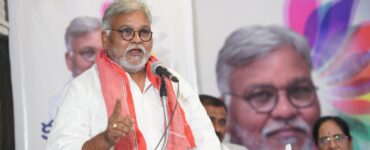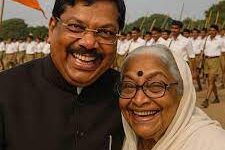Travelling inside India has changed drastically over the last forty years with most people now affording short-distance flights. This has made distances smaller, saving valuable time that we were told as kids, was ‘of utmost essence’ to the nation. But this haste entailed losses—I am hardly saying anything new by observing that traveling inside India also became increasingly impersonal. Gone are the random friendships of long journeys—times passed in ennui, as the dusty train crawled through Central India, blasted by the summer heat. One began friendly conversation, as soon as the initial fights about where whose bag would fit best, were over. As the train moved, packets of home-made snacks were brought out, and by the time the journey ended, everyone was exchanging addresses. Sometimes correspondences were kept up. But with time, inland letters lapsed into postcards, and an occasional ‘Happy Diwali’ card, before petering out entirely.
I travelled frequently with my mother—long distance journeys between Delhi and Pune from the end of 1970s, to almost the end of the 1990s. We lived in Delhi, and my mother, who was from Pune, often felt homesick. As a result, she and I regularly travelled to Pune—journeys that for her were full of nostalgia, brimming over with longing for home. Though I felt no nostalgia for Pune, these long journeys proved remarkable for my impressionable childhood years, as we rattled through places and stories with co-travellers. My mother was an interesting and adventurous traveller, a gregarious conversationist and an absolutely charming, if not slightly dramatic companion. This made traveling all the more romantic, as she imagined elaborate battle scenes in the empty countryside, her imagination transforming these empty places into destinations!
In terms of direct trains between Pune and Delhi, and before the Nizamuddin Goa Express began in 1987 (that left Delhi at the preposterous hour of 4am), we always travelled by the Pune Jammu Tawi Jhelum Express—the first direct train to Pune, started in 1979. Before that my mother and I (as a baby) first took the Dadar-Amritsar to Bombay and then the Deccan Queen. But our travel to Pune began in earnest only with the Jhelum. The Goa too, took the same route later, in contrast to other trains from Bombay that took the western route through Gujarat and Rajasthan to Delhi. Though both the Jhelum and Goa were officially said to take 23 hours to Pune, the Jhelum took between 30 and 35 hours—notorious for running ‘passenger’ between some stations, while running ‘superfast’ between others, when it ‘made up’ for delays. It was difficult to decide which was worse—the passenger mode, when we were put on ‘siding’ for hours, to free the tracks for express trains—or when we ‘made up’, with every surface inside the train shaking violently, and people on their way to the bathroom, looking like Tarzan swinging on branches. Someone always pulled the brake-chain at such times—their only way of communicating with the driver many bogies away, to go slow. Soon the railways started fining people for pulling the brake-chain.
While the Goa had a pantry car, with passengers not dependent on railway canteens at various junctions for food supply, railway canteen food, in metal trays with pre-made depressions for various items, was a treat. The Jhelum ordered passenger meals at railway canteens. Though the Goa was said to be more hygienic with caterers wearing plastic bags on their hands, and shower caps on their heads, I preferred the Jhelum arrangement, especially because the taste of the food changed as we travelled through India, introducing regional flavours to meals. Who would trade the insidious way in which peanuts made their way into food as soon as we entered Maharashtra?! The only thing I liked about the Goa pantry car was the regular tea, coffee, and Tomato soup that passed through. I loved the Tomato soup, though it was just diluted ketchup sprinkled with pepper. Sipping it gave me a ‘continental’ feeling. Each halt at a junction lasted 20 minutes at least, and one could stroll down the platform, buying cheap bestsellers, vernacular magazines, and newspapers. It was with relish that my mother pounced on the Marathi newspapers, as soon as we entered Maharashtra. While we travelled by normal three-tier sleeper in the Jhelum, we later began traveling by AC two-tier sleeper in the Goa. The Goa, as it was new, kept to its promised 23-25 hours since there were no ‘passenger’ stretches in the middle. However, my earlier and sweeter childhood memories still belong to the Jhelum. It taught me the route, which I still, vividly remember.
As we pulled out of New Delhi Railway Station and crossed the Pragati Maidan exhibition hall, and Humayun’s tomb, the train gained speed, stopping briefly at Palwal (in Haryana) before pulling into Mathura. Mathura was a pesky place. Hordes of young men got on to the train at Mathura, going short distance to Agra. Instead of taking local daytime passenger that would take them five hours, they got into express trains and crowded into general sleeper bogies to ogle the girls and squeeze into seats next to them. Once when a fellow passenger complained, one of the men said that this ogling would simply have to be tolerated since all men from Mathura were descendants of Shri Krishna, who also ogled girls. We would all have to calm down, and allow them to continue ogling. I was very happy when our train was once struck by a violent sandstorm at Palwal. So powerful were the gusts of wind, that the train rocked on its wheels. The driver, afraid that we would derail, stopped for three hours at Palwal, and by the time we dustily chugged into Mathura, all the Romeo-Shri Krishnas had left for the day. After Mathura, the journey to Agra was a dreary one that solely consisted of red brick walls lining either side of the tracks, covered with bold lettering printed in white Devanagari, all the way up to Agra, saying rishtey hi rishte! miliye professor agarwal, 26 raigarpura (for matrimonial alliances galore, meet Professor Agarwal at 26 Raigarpura). Agarwal’s matrimonial agency was so widely popularized along the railway tracks, and his advertisement ran on endlessly for so many kilometres and years, that it imprinted itself on my brain. I was once to put my foot (or pen) into my mouth, when describing professorial duties to include arranging matrimonial alliances in a standard 3 class test. The teacher, thunderstruck by the description, had demanded to meet my parents to understand how I had developed such ideas, despite they being university employees! Hardly did she know what professor Agarwal was up to, did she??!!
We always bought Petha at Agra (a sickly-sweet concoction of sugar and pumpkin) that my mother always imagined had the wings of dead flies still stuck to it. I enjoyed these sweets, and they lasted through the journey to Pune, with petha–petha–petha shouting vendors nearly shoving packets inside the window bars. The Jhelum stopped twice in Agra, first at Raja ki Mandi and then at Agra Cant (cantonment)—the food trays always came at Cant. We usually made good speed to Gwalior thereafter, with the countryside growing steadily flatter, more arid, and dusty, peppered over with small white chhatris that intrigued my mother. These small structures with domes on four pillars set on a small platform, perhaps covering a grave, lay forlornly in the countryside, in what seemed like never-ending abstract space that opened in all directions. The excitement really began in the late afternoon, as we crossed into Madhya Pradesh. The train stopped for a brief moment at Dholpur that technically fell within the boundaries of Rajasthan, just before crossing the Chambal, to let in armed police personnel. They locked the doors from within, and also pulled down the metal shutters over every window. One time an old Sikh couple traveling to Itarsi with us told us (mostly me) the story of the Chambal dacoits, and of Phoolan Devi, who had surrendered in 1982 to the MP Amar Singh government. The old Sikh gentleman who had worked in the Income Tax Department told me stories of caste injustice, gender, and poverty, and of the many dacoits or baghi gangs at large in the Chambal region. He was very patient with all my questions, and also explained gully erosion to me, that he said, made the shape of the arid Chambal ravines so special. This area locally known as the beehad had many small wild animals like foxes, and mongooses, but also dangerous snakes, and scorpions. I would peer out of the iron slats to gaze at that barren, plaintive, but also powerful landscape, imagining dacoits on horses galloping along, like in the movie Sholay, with its iconic background music. We would fly through Morena in superfast speed, and the closed, darkened, compartment, the metallic smell of guns and the smell of sweat mixed with bidi cigarettes on those uniformed men, along with the hot afternoon sun that slanted in from the bright orange beehad outside, full of dacoits and dangerous animals, made the journey to Gwalior quite tense and dramatic. Our train was once pelted with stones, and I was scared. But the train just sped on without any sign of having taken notice. The Chambal was an equally plaintive river, a small sluggish stream in a vast, vast riverbed. Its expanse was tremendous and the railway bridge across seemed to go on forever.
The old Sikh gentleman told us how he had once been in a train accident, where some train bogies had derailed and fallen into the water over a railway bridge, while one bogie hung precariously over the precipice, threatening to crash into the half-submerged bogies below. He said, the trauma had never really left him, and he still prayed every time a train crossed over any bridge. He recounted how the water had gushed in through windows that were barred, and how the door could not be opened. He was saved because the river was not deep enough, and being near the window on the upside of the bogie outside the water, he clung to its bars. It was like a well inside the bogie, where everyone else who could not cling to the bars first clung to others, and then fell below and drowned with everyone else who did not have the strength to continue clinging. It was worse than Partition, he said, a time in 1947 when he had come to India on someone else’s bullock cart, his own family lost, with ten rupees in his pocket. It had taken him eight years to find his family—and even then, something unfathomable was forever lost. The Sikh gentleman cried, and my mother comforted him and his wife. I realized for the first time how horrible the Partition must have been—perhaps like almost drowning in a train accident.
We swung on thereafter to Jhansi, and if the Jhelum was on time, one could see the hill-citadel of Jhansi fort looming over the city in the dusk. Jhansi was a romantic town flanked by Orchha—full of old, magnificent temples and picturesque palaces dating to the 16th century built by the local king Rudra Pratap Singh. In the Jhelum, the journey after Jhansi to Bhopal and the intermediate stations of Babina, Lalitpur and Bina was a twilight blur. Jhansi and Lalitpur were interesting for their location in a small pocket of UP that jutted into MP. So, you were in MP till Gwalior, and then suddenly back into UP, before re-entering MP again. Indeed, it was luck—one had either to be very early or very late, the latter more likely, to see the Betwa, that the train crossed, right after Jhansi. The Betwa is an extremely large river, similar to the Chambal, but has a fuller basin. Bhopal arrived sometime after midnight. Though one could peer from cracks beneath the window, it was important to not open the window at Bhopal. The Jhelum was washed, and its water storage refurbished in Bhopal. If you opened the window at Bhopal, you ran the risk of being caught in a cascading waterfall. It was in any case difficult to open the window in a three-tier sleeper at night, when someone was sleeping on the middle-berth. But I found it comforting to observe people at night-time stations, their darkened shapes walking along, or sitting huddled in the dim tube lights of platforms, among large jute-covered, tied parcels, with the platform announcing the train’s presence in staccato spurts. New passengers climbed in blindly at such stations into the darkened, blue-lit bogies that resounded with snores and other, more gastric sounds, searching for their reservations, and waking up people who were occupying their berths. It was comforting to see people on their own journey but in the same direction you were going. It was a kind of solidarity, though a slightly irritating one, as new passengers loudly called to one another, and discussed and haggled rates with porters, unconcerned about the sleeping others.
It was only with the Goa that one beheld the exquisite beauty of Southern MP. The region around Bhopal is breathtakingly beautiful—a hilly, forested, and extremely scenic world, in sharp contrast to the lonely and plaintive beehad. One can almost ‘feel’ Bhopal arriving, as the train crosses Vidisha, home to the famed Buddhist stupas at Sanchi. If one was lucky, one could see the Sanchi Stupas, though what I saw from the train did not prepare me for the grandeur of what I beheld when I first visited Sanchi. More romantic were the craggy mountain edges of Bhimbetka, looming in the distance, outlined against the sky. A world heritage site now, Bhimbetka is home to some startlingly beautiful prehistoric cave painting from the Mesolithic period—men, women, animals (huge wild boars especially), children, all busy with their hunting-gathering, and cooking. These are poignant painting, spread over a larger expanse of the Raisen district in MP, that is home to many other prehistoric cave painting sites like Lakhotia, Jaora, or Kathotia. Shamla Hills in Bhopal itself, preserved by the National Museum of Man has some beautiful rock shelters and cave paintings. Bhopal is a beautiful city with many lakes, its Hindi dialect special for its playful, courteous, and sing-song style. The magic of forests soon began, as soon as one left Bhopal, passing Mandideep, and Obaidullaganj. One was suddenly in the heart of the shaded foliage—deciduous trees of the Mahadeo Hills with large leaves, the route replete with many hairpin turns, enough for one to stick out one’s head from the window to wave at the driver, as the train curved ahead. One crossed the mighty Narmada just before pulling into Hoshangabad.
The Narmada is nothing like the flat rivers of the plains. It flows in a deep and rocky ravine, a rift-valley formed from the volcanic activity of the Vindhyas and Satpudas, gushing mysteriously and strongly. It is said that the Narmada separates the people of India, in terms of their perspective to life, dividing the more passive and degenerate North from the ferocious and cultured lands of the South. Hoshangabad is beautiful—full of tiny rivulets, waterfalls, and mountain tunnels all the way up to Itarsi. This is also an Adivasi region, with Betul sporting one of the biggest annual ritual witch-hunting festivals called bhooton ka mela (a fair of ghosts). Hoshangabad is also home to many self-styled village education programs that have had academics like the renowned Anil Sadgopal, give up their university careers, to teach Adivasi children science.
Instead of going south from Itarsi, the Jhelum and Goa both, deviate sharply to the west, thereafter, heading straight to Khandwa on the borders of MP and Maharashtra. A great many parcels are loaded on to the train at Khandwa, and skipping Burhanpur, where Mumtaz Mahal died and was initially buried before being exhumed and transported to the Taj in Agra, both the Jhelum and Goa first touched base in Maharashtra at Bhusawal, after crossing the Tapti. It was from Bhusawal henceforth that one encountered the Gandhi cap, the broad trouser (lenga), and the nine-yard sari, much to my mother’s delight. We mostly sped in ‘superfast’ mode, thereafter, stopping shortly at Jalgaon, and Chalisgaon, the latter being a short distance away from Malegaon where my mother’s great grandfather had been a Marathi pastor for 26 years, and where he also lay buried. Malegaon was also famous for other reasons: the Maratha fort of Malegaon manned by Arab mercenaries of the Peshwas held out the longest against British occupation in the Anglo Maratha war of 1818.
Breakfast came at Manmad, a place immortalized in public imagination by the Ankai Dongar or the ‘Thumbs Up’ hill. Ankai is a hill eroded to produce the hilltop as an enormous thumb—an important landmark of Manmad. It was after Manmad that one saw the Satpudas gradually give way to the layered Sahyadris. Manmad—Dhule and Nandurbar were also Adivasi areas, and extremely arid, though nothing compared to the beehad. The train wound its way around impressive, layered mountains with fort tops after Manmad, making the journey onwards to Ahmednagar picturesque and mostly uneventful. The Jhelum, in the late 1980s, imitating the Goa, introduced a new stop at Kopargaon on the Godavari. Many passengers alighted there to go to Shirdi. The Shirdi station is emblazoned in my memory as a place that boomed with Rishi Kapoor’s Shirdi-wale Saibaba, a song from the film Amar Akbar Anthony. Rahuri was another interesting place just before Ahmednagar. Known as the Peshwe Inam given to Vinayak Damodar Savarkar’s family, the Savarkars enjoyed Kulkarni-ship rights there till Independence—never having worked in the Peshwa army or lashkar and therefore, never forced to give up any property during the British takeover in 1818.
The journey between Ahmednagar and Daund was extremely dreary. The Jhelum ran as a daytime ‘passenger’ between Ahmednagar and Daund, taking almost four hours to cover the stretch. This included long hours on ‘siding’, allowing other ‘superfasts’ precedence. Lunch came at Ahmednagar, by which time peanuts were firmly entrenched in the cuisine. My mother’s cousin, whose family was connected to the American Mission and Pandita Ramabai’s Mukti Mission at Kedgaon, lived in Ahmednagar. She would find out when our train was arriving, and always came to the station with her family to welcome us, bringing goodies along. This meeting was an appetizer in many ways—the first loving family meeting with many hugs, that made us anticipate our arrival in Pune ever more urgently. The Jhelum in her ‘passenger’ mode stopped everywhere after Ahmednagar: Visapur, Pimpalgaon, Belwandi, Shrigonda, Kashti, and a number of other places. My mother always got off the train at Visapur, each time enumerating the number of years it had been since she had last touched her feet to the ground there. My mother grew up in Visapur, where my grandfather was posted as Jailor, before moving to Pune as Jail superintendent of Yerawada prisons. He retired as Deputy IG Prisons Maharashtra, and educated in Leeds, continued to teach Juvenile Delinquency as a subject, at the Jail Officers Training School as honorary staff member till he passed away. Visapur held a special place in my mother’s heart. It was the place of her childhood.
The exhausted train finally pulled into Daund after crossing the mighty Bhima. Daund had a large Muslim population, and a new Biriyani shop had opened at the station in the early 1980s. We always made a beeline for the Biriyani shop, where the chacha would pile the luscious concoction into special plastic lined boxes, packed and ready to go. My mother and I, feeling left out by civilization by that time, pounced on the Biriyani, as if we had never seen Biriyani before. This Biriyani became so famous with long-distance train passengers, that all the platforms at Daund station soon ran branches of chacha’s shop. Passengers could be seen, bounding out of long-distance trains, and queuing up for their Biriyani shot in the arm, and soon, chacha’s one-man venture had grown into a huge business—having recognized the suffering of long-distance travellers!
My mother always played a cruel trick on me as we left Daund. Daund was a one-way railway junction, where trains coming in, had to necessarily take another direction while pulling out. It felt like the train went backward when leaving Daund. My mother always told me we were returning to Delhi. It was a cruel joke, not because I was fond of Pune, but because we had been travelling for more than 30 hours and feeling (and looking) like wild apes, dying to reach our destination by then. Daund also had a huge army of beggar boys, all about eleven or twelve years old, who came into the bogie with rags, cleaned the floors and begged. Passengers already in preparation of alighting in Pune, gave these boys all their remaining food and a few rupees. We always bought an extra packet of Biriyani for the beggar boys. For many years, when I complained about the food, my mother reminded me of the beggar boys in Daund.
No train description is complete without toilet stories, and Indian train toilets are indeed scary, where one has to pass motion in the perilously jerky rhythm of the train. It made going to the toilet a surreal and precarious, though thankfully brief, and generally incomparable life experience—unless comparing it to an acrobat who had to drink a glass of water while turning cartwheels. Also, train toilets are places of male lust, with the graffiti inside on the walls coming to include phone numbers by the mid-1990s. This graffiti provides an equally precarious image of the female body, its various sexual functions, the many vernacular nomenclatures attached to it, and how it was an object of incest aversion and incest voyeurism at the same time. But that aside, I remember the train toilet for another remarkable incident.
My mother and I had gone to “freshen up” once when the train stopped at Manmad. Doing one’s business when the train was stationary, felt safer. So, finding a toilet free, my mother ran in. Now, train toilet doors always opened inwards, to save space in the tiny vestibule outside, that led to the conjunction between bogies. This conjunction was another scary place, because both bogies moved differently—a place I often saw beggars sleep. It was a mystery. Now a greatly bearded Sadhu Baba, with matted dreadlocks piled high into an impressive top knot, climbed in at Manmad. He first sat at the conjunction, transcending all fear of the differently moving bogies, but then changed his mind, and moved into the vestibule, leaning his back against a toilet door. It was the same toilet my mother was inside. I looked on in interest as I brushed my teeth at the small metal basin just inside the door. The Sadhu was burping to himself saying Hari Om at intervals, stroking his beard. He had no idea that he was leaning against a toilet door. Now suddenly, my mother, her business done, opened the toilet door, which of course, opened inwards. The Sadhu Baba taken aback that his backrest had suddenly vanished, fell in backwards, his poor legs in the air, on my mother’s feet. My mother in the meanwhile having drawn her own conclusions about the sudden onslaught, screamed loudly. She thought a dog had entered the train at Manmad. She could, moreover, not be blamed for forming such an impression, since the Sadhu Baba’s matted top knot was significantly large, and well, hairy. So, my mother started screaming in Marathi arey kutra! Kutra! (a dog! a dog!) All hell broke loose. People rushed to retrieve the Sadhu who seemed to be unable to pick himself up from my mother’s feet. My mother too realized that a man was connected to the hair. Others were dying with suppressed laughter, and the Sadhu Baba, his top knot askew, was in complete shock. My mother was made to apologize to him for calling him a kutra. But it worked out somehow for the Sadhu Baba, because, being visibly shaken by the sudden event and all that, he was given a seat by the TC. We bought him a packet of Biriyani at Daund, and though we were doubtful he would eat the meat, I saw him gorging on the Biriyani, his face turned to the wall, as I went to comb my hair in the mirror of the washbasin, before alighting in Pune.
The five stations between Daund and Pune when the Jhelum went ‘superfast’, disappeared in a flash. We counted the stations off our fingers—the yellow signposts announcing the station names becoming just a blur: Patas, Yavat, Uruli, Loni, and Hadapsar. We usually came to a grinding halt just outside Pune, under the Wadia college bridge, as we waited for the allocated platform to become free. My mother had studied for her graduation in Wadia, and she brought out the usual stories of college escapades, that were the same every year, as we twiddled our thumbs impatiently. This time was used to spruce up, get our bags out from their resting place under the berths, collect our belongings, and search for our footwear. We hastily said goodbye to our co-passengers, who were also getting their things together, and standing up in a way that indicated finality. They also began looking a little different from this moment on, like familiar, but formal strangers, even as we exchanged addresses.
We recognized my grandparents waiting at the railway station even before we actually saw them clearly. Our loved ones look so familiar and yet different, especially when meeting them after a long time. Despite being unwashed and grimy, we would be hugged and welcomed, the foreign feeling disappearing by the time we reached home—my mother chattering nineteen to the dozen. My grandfather did continue to lovingly tease me for the first week after arriving in Pune though, calling out to me as O Dilliwale! It was the same in the return journey, when meeting my father at New Delhi after a resounding holiday in Pune. He looked familiar, and yet different. These are the moments when we see people as they are, beyond the relationships we have with them. And the journey of 35 hours is a watershed that re-creates home and destination on either side of it, as people and families. This feeling of meeting my parents after a long watershed journey remained with me for many years, as I returned from Germany to Delhi each time—my parents awaiting me, looking surreal at the midnight hour, outside Terminal 3 of the Indira Gandhi International Airport—a little bent and older, but the same—full of the childhood love.
*









Add comment